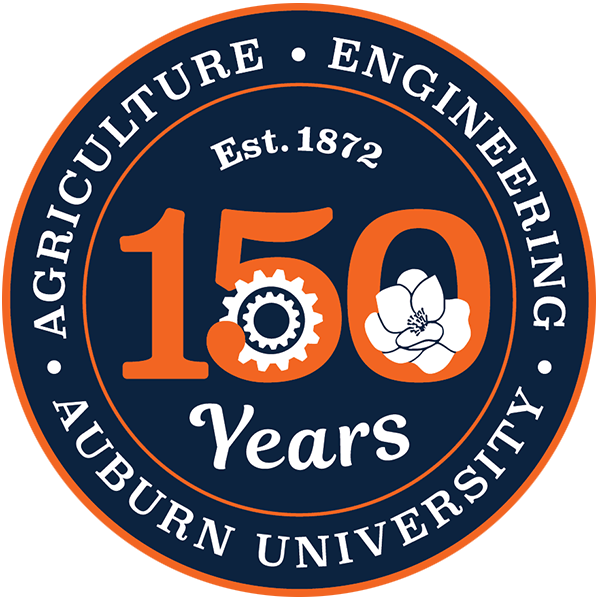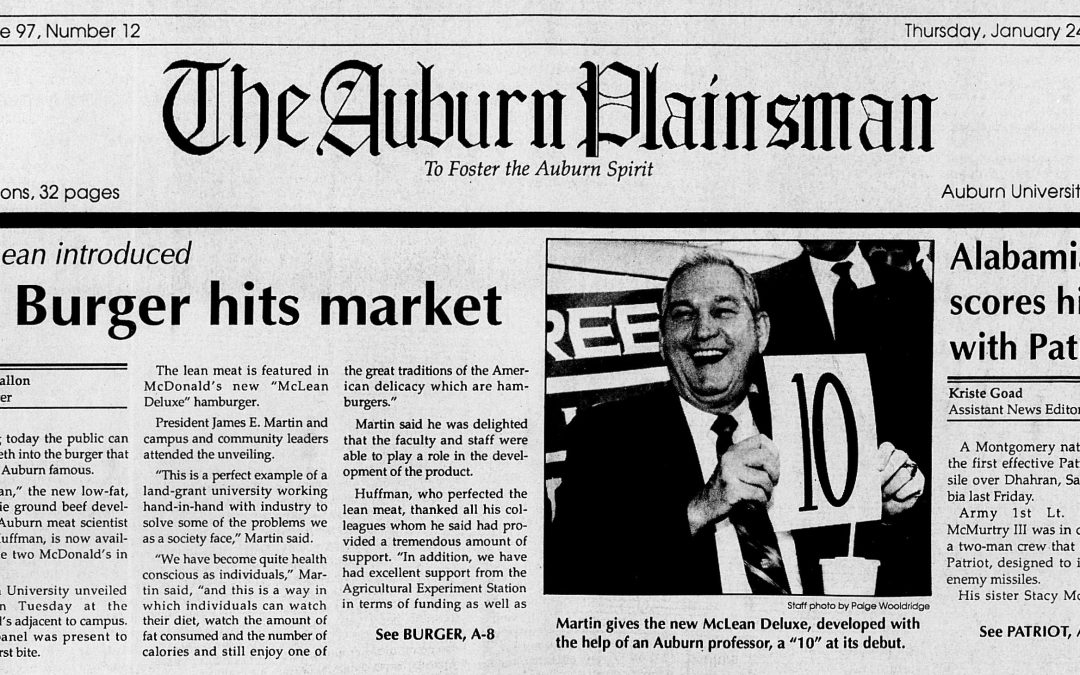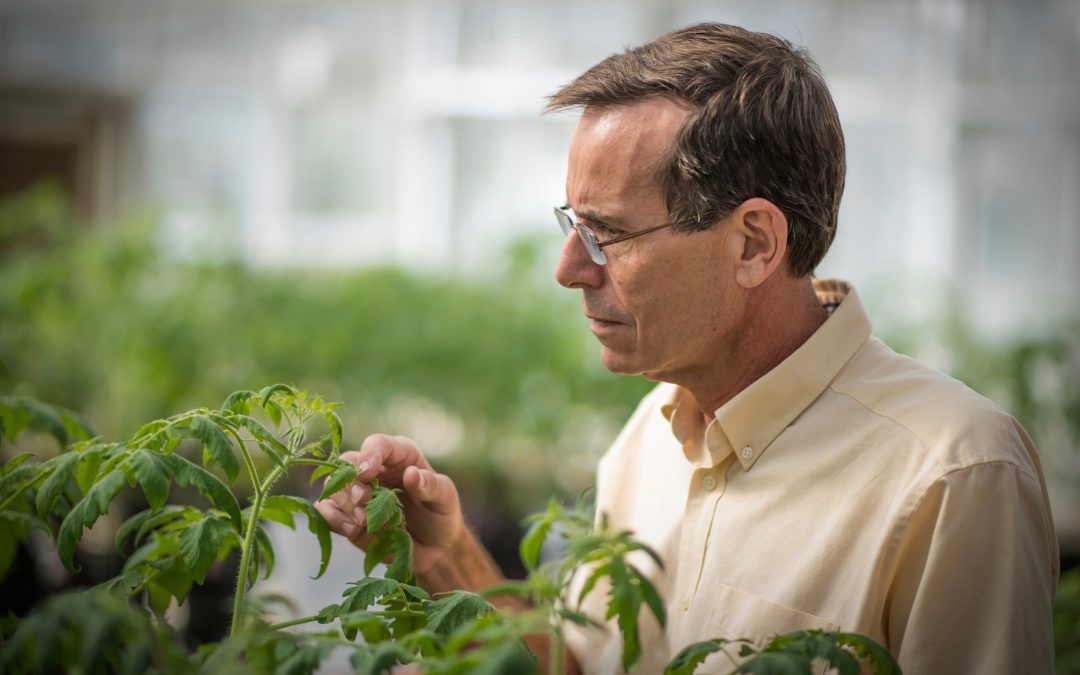Auburn’s beloved Toomer’s Oaks live on in multiple ways
Throughout the 2022-2023 academic year, the College of Agriculture is celebrating its 150th anniversary with content shared from its special edition, collector’s book of The Season, publishing in 2023.
By Mike Jernigan
It was in the early morning hours after a big Tiger football win that an angry fan from another SEC school decided to put an end once and for all to the hallowed Auburn tradition of rolling the 80-year-old live oaks at Toomer’s Corner with toilet paper in recognition of a major sports victory. Killing the trees, he thought, would put an abrupt end to the tradition.
But this was November 2001, long before the late Alabama fan Harvey Updyke would forever go down in Auburn infamy for fatally poisoning the trees with herbicide after the Tiger’s epic 28-27 Iron Bowl win in Tuscaloosa. And this first attempt by an opposing fan to destroy the Toomer’s Oaks by setting the toilet paper draped over them on fire was a failure, thanks to the quick response of the Auburn Fire Department.
In a way, the failed attempt on Auburn’s beloved oaks was a blessing in disguise, because it brought home the realization to university officials that the trees were vulnerable and could be lost at any time to vandalism, disease or natural disaster. And that they had become far too important to the Auburn Family not to be protected and preserved in some way if possible. Following a meeting of administrators from the School of Forestry and Wildlife Sciences and the Campus Tree Committee, acorns were collected from the trees the following fall, and soon, seedlings from them were not only planted as a backup for the old oaks, but were made available to Auburn alumni and friends as well.
“We started out growing seedlings to replace a couple of trees at Toomer’s Corner,” related Dick Brinker, Dean Emeritus of the School of Forestry and Wildlife Sciences, in a 2020 interview. “But we thought students might be able to make money for their clubs by selling seedlings to alumni who wanted a piece of Auburn in their own yard. Students packaged and shipped each individual seedling. The project took off and students were shipping about 600 seedlings a year until the parent trees met their untimely end in 2011.”
That untimely end a decade later was first foreshadowed on a sports radio call-in show, when Updyke — using the pseudonym “Al from Dadeville,” — proudly boasted he had traveled to Auburn in the dead of night specifically to poison the soil around the oaks with Spike 80DF, a deadly herbicide typically used to kill trees and brush along fence lines. Updyke insisted the poisoning was in retaliation for perceived slights by Auburn students to Alabama traditions. But that someone would do such a thing seemed slightly unreal; that they would do it and then brag about it on national radio seemed even more so.
Gary Keever, now retired, but at that time a professor of horticulture in the College of Agriculture and a member of the university’s Tree Preservation Committee, would become the face of the university’s efforts to save the trees, and later their removal and replacement. “My first reaction to the call was disbelief,” he recalled. “No one would publically announce committing such a crime. But we collected soil samples from beneath the trees next morning for analysis. In February we received the results, confirming a high presence of tebuthiuron, or Spike 80DF.”
The old oaks were doomed from the start because test results showed the lowest amount of the poison detected in the soil around the trees’ bases was 0.78 parts per million, described by horticulture experts as a “very lethal dose.” The highest amount detected was 51 parts per million, or 65 times the lowest dose. Experts believed even a normal application of the herbicide would have been enough to kill the trees.
Keever was one of the first to share the bad news with the Auburn family. “We are assessing the extent of the damage and proceeding as if we have a chance to save the trees,” he announced in a press conference after the results were in. “We are also focused on protecting the other trees and shrubs in Samford Park. At this level, the impact of the poison could be much greater than just the oaks on the corner, as Spike moves through the soil to a wide area. Additional tests are being completed to determine the movement and extent of the area affected.”
Despite the grim prognosis, Herculean efforts were made to save the oaks. The Auburn faithful would accept nothing less. “We will take every step we can to save the Toomer’s Oaks, which have been the home of countless celebrations and a symbol of the Auburn spirit for generations of students, fans, alumni and the community,” said then-University President Jay Gogue, an Auburn man himself.
Dow Chemical, manufacturer of the herbicide, was consulted. Poisoned soil was dug out from around the trees’ roots. New soil was added. Dead limbs were pruned. Various treatments were tried. Rolling the trees was temporarily banned. No stone was left unturned in Auburn’s attempts to save the oaks. But they were all in vain. The iconic trees rapidly became sad skeletons of their former selves. Each year the trees put on new leaves in the spring — attempting to heal themselves — but fewer and fewer survived. The decline continued.
By 2013, it was clear the end was near. On A-Day of that year, more than 80,000 fans journeyed back to campus to see the spring football game, but mainly to bid a sad farewell to a fondly remembered part of their collective Auburn experience. The trees were rolled one final time. Many people left notes and poems on the weathered trunks and limbs that remained; recollections of rollings past, or expressions of their very personal grief at the oaks’ passing. Perhaps no other trees have ever evoked such an emotional outpouring from so many people.
Three days after the crowds had gone, the old oaks were cut up and removed. But their legacy would live on. As the old trees declined, President Gogue had established a committee of university stakeholders and the Auburn Family was polled as to what the oaks should be replaced with if they failed to rally. The seedlings from the oaks that had been grown starting in 2002 were considered, but the consensus was that larger trees — and once again live oaks — were preferable.
Keever was part of an Auburn group that toured a tree plantation in South Carolina, selecting three live oaks from among 9,000 candidates. “We had certain criteria we wanted for the trees,” he explained. “The lowest branches had to be above head height, and we wanted to have trees that would be difficult for fans to climb. We were also looking at some traffic concerns with the branches.”
The 35-foot trees were trucked back to campus, two bound for Toomer’s Corner and one to be planted elsewhere on campus as a spare. “In preparation, the entire corner was excavated to a depth of three feet, and six feet in the areas where the two replacement trees were to be replanted,” Keever noted. “A drain was installed beneath both planting sites to carry water away from the trees in case any contamination remained in the area. A soil mix based on that from a live oak’s natural habitat was added to bring the grade back up to its original level.”
Once everything was ready, the new oaks were planted in February 2015. Even though the university asked fans not to roll them while they were acclimating to their new environment, the Auburn family was happy to have trees back on the corner that held the promise of one day seeing the Toomer’s tradition renewed. But the trials and tribulations of Auburn’s oaks were not over.
One of the new trees had to be replaced six months later after it failed to thrive. Then, in September 2017 — in almost a replay of the 2001 fire incident — the healthier of the two trees, on Magnolia Avenue, was rolled after a football win over LSU and set alight by a visiting German tourist. The tree was badly damaged, and a decision was made to remove both oaks and start over with slightly smaller trees, which hopefully would tolerate transplanting better. These young live oaks, which came from central Florida and have adapted much better, are the trees gracing Toomer’s Corner today.
The original oaks’ presence lives on in other ways as well. In 2001, after the first fire that demonstrated the vulnerability of the trees, Scott Enebak, now an associate dean and professor in the School of Forestry and Wildlife Sciences, initiated the program to ensure the legacy continued. Under his leadership, Forestry Club and Wildlife Society members cultivated acorns from the original trees and raised the seedlings. Some of those oaks still remained and were approximately 15 years old and 15 feet tall in 2016, when 10 of them were planted along the sidewalk between the corner and Samford Hall.
For those who want a branch of the Toomer’s tradition a little closer to home, there is another option. Keever collected acorns from the original oaks in 2007, and now those seedlings are 10-12 feet tall. But numbers are very limited. In addition, rhizomes collected after the original trees were removed have been used to produce genetically identical clones of the original Toomer’s Oaks. Both seedlings and clones are available for purchase from the College of Agriculture.
“Current trees being sold are grown specifically within the Department of Horticulture in the College of Agriculture,” said Heath Hoffman, associate director of the Agricultural Research and Extension Center, who oversees the sales. “Student workers help with the growing and maintenance and proceeds support the clone program and student activities at the Paterson Greenhouse Complex.”
Clones may be purchased through the college and include a certificate identifying the tree as a direct descendant or clone of the original Auburn Oaks at Toomer’s Corner as well as planting and care instructions.
However they are honored or remembered, it is clear that the original Toomer’s Oaks are gone, but not forgotten. They live on in the memories of generations of Auburn Family, as well as in their descendants planted on campus and in the yards of thousands of alumni and friends across the south. Whatever else happens, the Auburn tradition of the Toomer’s Oaks will always roll on.





